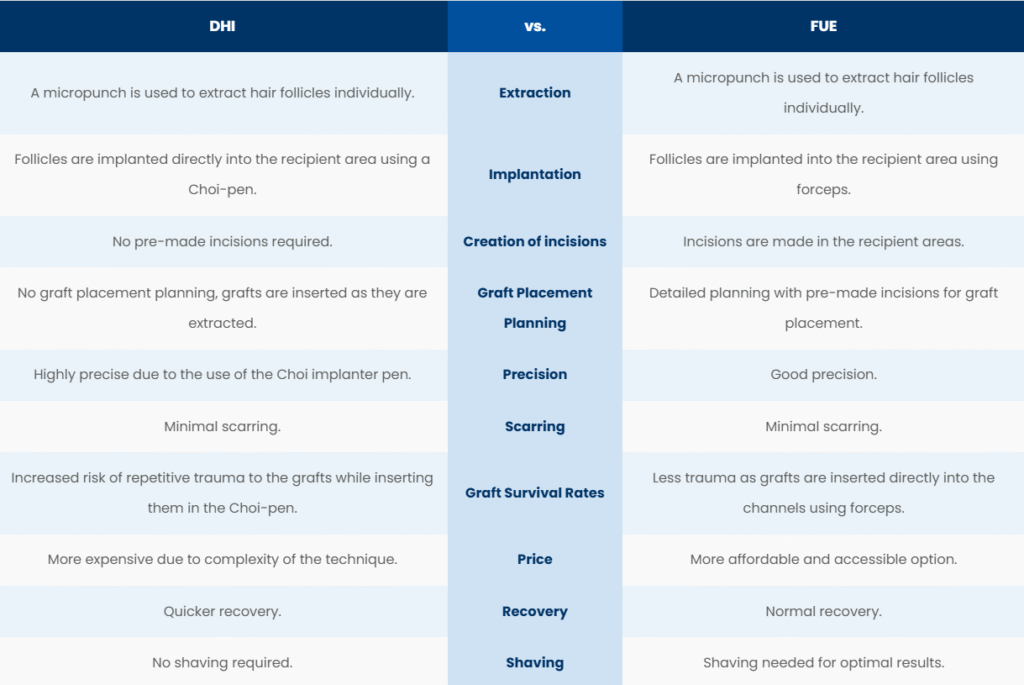DHI vs FUE: Which Is The Best Hair Transplant Technique?
What Is DHI Hair Transplant?
Direct Hair Implantation (DHI) hair transplant is one of the latest hair restoration techniques. Using a specialized implanter called a Choi-Pen, grafts are implanted directly into the scalp without the need to create incisions in the recipient area.
For more detailed information on DHI Hair Transplants, click the following link: DHI Hair Transplant
Advantages Of DHI Hair Transplant
Here are the main advantages of opting for a DHI hair transplant:
- Minimally Invasive: DHI requires no pre-made incisions.
- Precision: Using an implanter pen ensures accurate placement of hair grafts, resulting in natural-looking hair transplant procedures.
- Reduced Risk of Scarring: Since hair follicles are directly implanted without incisions, the risk of visible scarring is greatly reduced.
- Faster Recovery: Patients generally experience a quicker recovery period compared to other hair transplant methods.
- Adaptability: DHI is particularly suitable for no-shave hair transplantation.

What Is FUE Hair Transplant?
Follicular Unit Extraction, or FUE, is a minimally invasive hair transplant method that involves harvesting hair follicles from the safe donor area individually and implanting them into bald or thinning areas. This extraction method uses a manual or motorized micro-punch tool to extract follicles one by one, resulting in minimal scarring in the donor area.
For expert insights on FUE Hair Transplants, visit the following link: FUE Hair Transplant
Advantages Of FUE Hair Transplant
Here are the key advantages of choosing a FUE hair transplant:
- Minimally Invasive: There are no large incisions or excisions, and this reduces discomfort
- Natural Results: FUE allows for precise extraction and placement of individual hair follicles, ensuring natural-looking results.
- No Linear Scarring: Unlike traditional FUT hair transplant, this method only results in dot-like, barely visible scars in the donor area, which can easily be camouflaged by your hair.
- Quick Recovery Time: Recovery time is shorter, enabling patients to return to their daily lives within a few days.
- High Graft Yield: A large number of grafts can be extracted in a single session, making it suitable for patients with extensive hair loss.
- Flexible Donor Areas: Hair follicles can be harvested from different parts of the body, such as the beard, chest, or limbs, making it ideal for patients with limited donor hair on their scalp.
DHI vs FUE Hair Transplant: The Key Differences
The fundamental difference between DHI and FUE hair transplant techniques lies in their names: FUE (Follicular Unit EXTRACTION) refers to the method used for extracting hair follicles, whereas DHI (Direct Hair IMPLANTATION) pertains to the method of implanting hair follicles.
In most parts of the world, grafts are extracted using the FUE method in both traditional FUE and DHI hair transplants. While some doctors still use Follicular Unit Extraction (FUT) for extraction, it is becoming less common.
In traditional FUE hair transplantation, the implantation phase consists of a two-step process. The hair transplant surgeon creates small incisions (also referred to as channel openings) in the recipient area. Once the grafts are extracted, they are placed into these tiny incisions using forceps.
On the other hand, DHI hair transplants do not require pre-made incisions. After extraction, the grafts are loaded into Choi-pens or implanter pens, which allows the hair transplant specialist to implant the grafts directly into the recipient area.
DHI vs. FUE: Which Hair Transplant Method Is The Better Choice?
When it comes to selecting a hair transplant method (DHI or FUE), the decision depends on your own needs and preferences. Both techniques have their pros and cons, making them suitable for different types of patients.
It is essential to assess the benefits and risks of both DHI and FUE techniques when choosing the best hair transplant method for your specific needs. The table below can help you decide which approach to use to resolve your hair loss.

DHI vs. FUE Hair Transplant: Recovery Time
Due to the lack of pre-made incisions, DHI hair transplants generally have a shorter recovery period than FUE hair transplants. The DHI hair transplant technique minimizes tissue trauma, leading to minimal discomfort and faster healing. Patients can resume regular activities 3 to 5 days after the procedure.
FUE hair transplants usually require 5 to 7 days for recovery, as patients may experience mild discomfort and swelling in both the donor and recipient areas.
DHI vs. FUE Hair Transplant: Graft Placement Planning
Graft placement planning is a critical part of both FUE and DHI methods as it directly affects the final hair transplant results. In FUE hair transplant, the doctor determines where the grafts will be placed w
FUE vs. DHI Hair Transplant: Graft Survival Rate
When it comes to graft survival rates, FUE can offer a slight advantage over DHI hair transplants. In the DHI technique, there is an increased risk of causing repetitive trauma to the hair follicles when they are being inserted in the Choi Implanter Pen, potentially reducing their survival.
In FUE hair transplants, this risk is minimized, as the hair follicles are inserted directly into pre-made incisions, which can help improve graft survival rates.
DHI vs. FUE Hair Transplant: Price Comparison
When comparing the costs, DHI hair transplants tend to be more expensive than FUE hair transplants. This price difference is mainly due to the use of specialized tools, such as the implanter pens, the increased time and precision required, and the skills necessary for the procedure. DHI also requires more medical staff to load the hair follicles in the Choi pen.
The FUE hair transplant technique is comparatively more affordable as it’s a widely practiced technique, and the procedure time is quicker since grafts are implanted using forceps after the pre-made incisions are created.
DHI vs. FUE Hair Transplant: Which Is Better For Density?
In terms of improving scalp hair density, both DHI and FUE hair transplant methods can be used to achieve excellent results. However, there are some subtle differences.
DHI technique ensures a more precise graft placement since the implanter pen can control the angle, depth, and direction of each follicle. This is especially suitable for smaller or specific areas, such as hairline work, when more attention to detail is required.
When performed by an experienced hair transplant specialist, FUE can be just as effective. The FUE hair transplant method can be better suited for covering larger balding areas since it allows for faster implantation in larger sessions.
DHI vs. FUE Hair Transplant: Which One Provides Natural Results?
Both DHI and FUE procedures can deliver excellent, natural-looking hair transplant results. The key factor to natural results is not necessarily the technique but rather the skill and experience of the hair transplant specialist, the hairline design, and graft placement. A talented hair transplant doctor can achieve the desired natural results using any hair transplant method.
DHI vs. FUE: Which Technique Is Better For Beard or Eyebrow Transplant?
DHI method is generally considered the gold standard for beard and eyebrow transplants. The use of implanter pens ensures precise control over the angle, direction, and depth while inserting the grafts. This is essential in delicate areas such as the face, where every little detail matters.
While FUE is still a viable option for eyebrow or beard transplants, DHI typically results in more accurate and aesthetically pleasing results.
Is DHI Hair Transplant More Painful Than FUE?
DHI and FUE hair transplants are both considered almost painless procedures as they are performed under local anesthesia. While the first couple can cause some mild discomfort, the rest of the surgery is usually painless once the anesthetic starts to work.
The level of pain experienced after the hair transplant procedure is minimal or non-existent and can be managed using over-the-counter painkillers.
Choosing The Right Hair Transplant Surgeon For DHI or FUE
Choosing the right hair transplant surgeon for FUE or DHI is essential to achieve the desired results. While some doctors can perform both hair transplant techniques, some choose to specialize in DHI, and others have extensive experience with FUE. It is vital to research the qualifications, experience, and area of expertise of the hair transplant surgeon before undergoing the procedure.
At Civas&Akpınar Hair Transplant Clinic in Ankara, Turkey, our doctors are skilled at both FUE and DHI hair transplant methods, boasting a high success rate. During your initial consultation, they will determine the best hair transplant technique for your unique needs and your hair goals while also taking your preferences into consideration.
For a comprehensive consultation with the best hair transplant surgeons in Turkey, please fill out the consultation form below, and we will get in touch with you.
March 5, 2025


